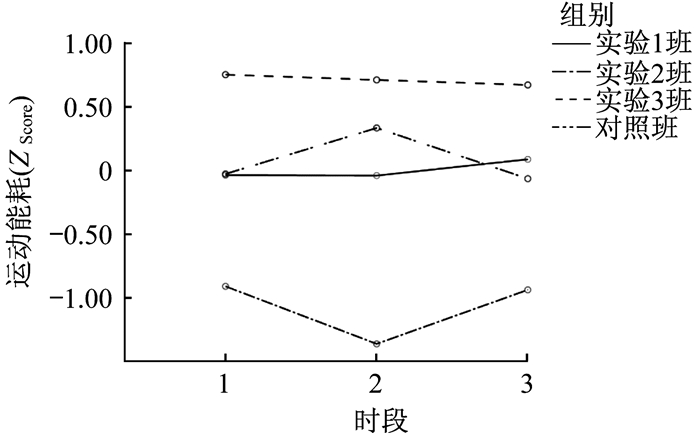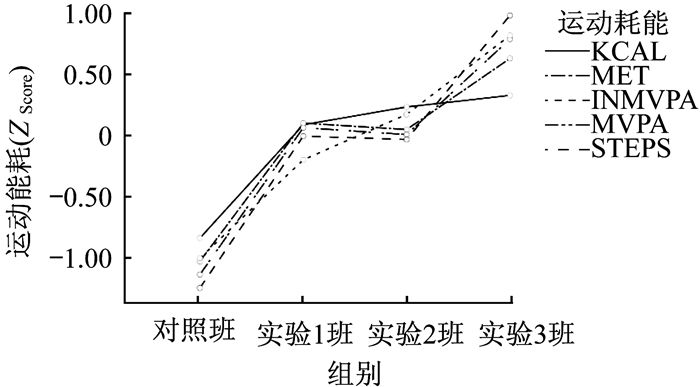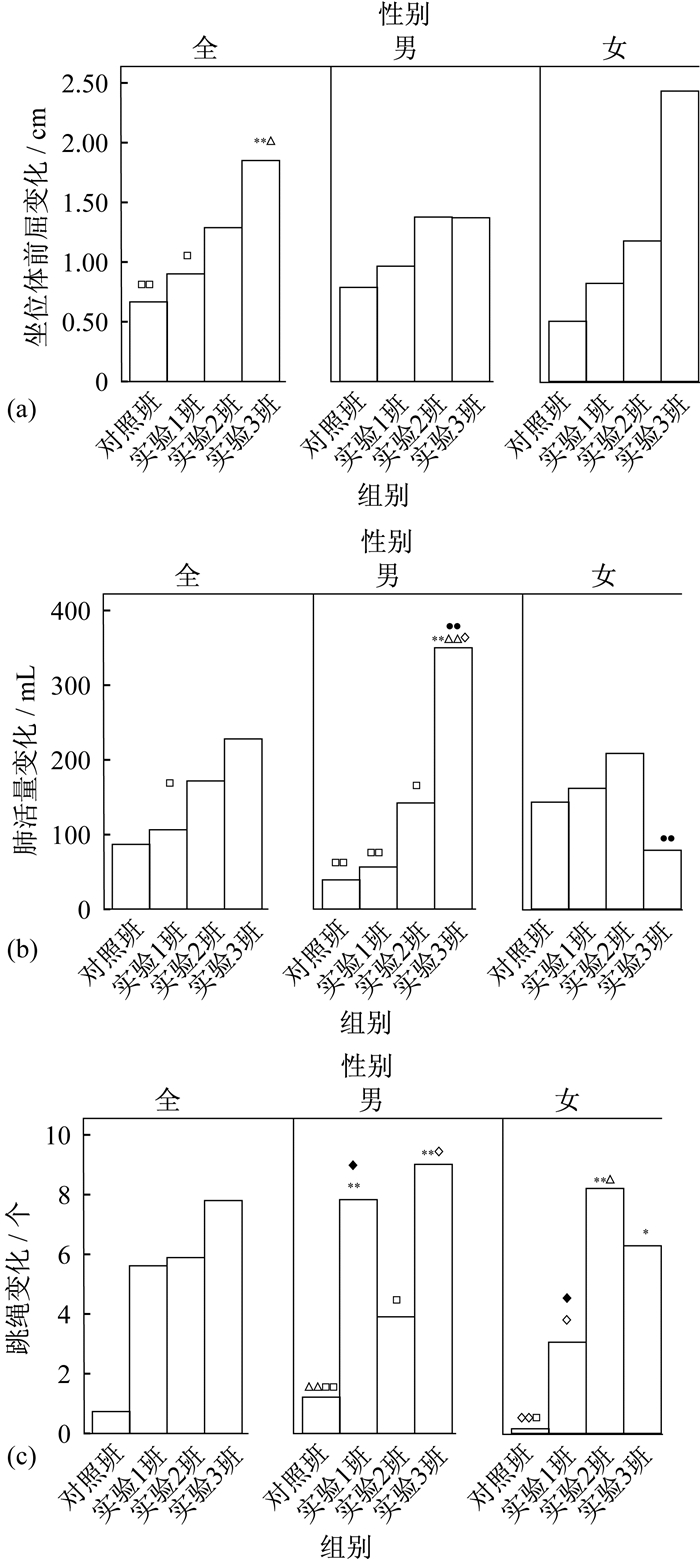Influence of Exercise Time to Adolescents' Energy Consumption & Physical Fitness
-
摘要:探讨60% THR运动强度下不同运动密度对青少年运动能耗与体质健康的影响。方法: 将146名健康小学生随机分成低、中、高运动密度组和对照组,分别采用Polar Team OH1和Actigraph wGT3X-BT监测运动强度和运动能耗。结果: 运动能耗建模后,时段以及时段与组别交互作用无统计学意义,运动能耗与组别交互作用有统计学意义;体质健康建模后,BMI变化、往返跑、50 m跑和坐位体前屈进步幅度组别主效应以及肺活量、跳绳进步幅度"组别×性别"的交互效应均有统计学意义,仰卧起坐组别主效应和"组别×性别"交互效应均无统计学意义。结论: 60% THR运动强度、36%~74%运动密度的运动负荷是维持身体基本运动能力的最小阈值,55%~74%的运动密度是引起BMI下降的最小阈值并适宜发展女生跳绳能力,75%以上运动密度是健康促进效应和提高运动能力的价值阈。Abstract:This study aims to investigate the effects of different exercise time (ET) on energy consumption and physical fitness of adolescents at 60% THR exercise intensity.Method: 146 healthy pupils were divided into low (LET), middle (MET), and high (HET) ET groups, along with a control group (CET).The exercise intensity and energy consumption of these groups were respectively assessed using Polar Team OH1 and ActiGraph wGT3X-BT triaxial accelerometers.Results: After modeling energy consumption patterns with these four ET groups, this study concludes that there were no statistically significant main effect of periods or interaction effect of "periods×group".The interaction effect of "energy consumption×group", however, did prove to be statistically significant.The main effect, in BMI changes, as well as improvement in the shuttle run, the 50 meter dash, and the sit and reach test, was statistically significant.Lastly, the interaction effect of "gender×group" on the improvement of lung capacity and rope skipping ability was statistically significant.There were no statistically significant differences in "group×gender" or groups or gender in sit-up test performance.Conclusions: The combination of 60% THR exercise intensity and 36% 74% ET is the minimum threshold for maintaining basic bodily fitness for adolescents; and 55% 74% ET is the minimum threshold for BMI decline and skipping rope improvement (however, this does not apply to males) among females; 75% ET is the minimum necessary to promote bodily fitness and the overall improvement of exercise capacity.
-
Keywords:
- adolescents /
- exercise time /
- exercise intensity /
- energy consumption /
- physical fitness /
- school sport
-
众多研究较一致地认为, 中国早期(1840—1949年)的现代化属后发外生型的现代化, 与早发内生型现代化国家比较, 现代化的推进力量是“自上而下”, 其一般是由被动的“依附型现代化”向自主的“赶超型现代化”逐步升级的过程, 导致民族化与世界化并存, 较低的经济水平和较高的物质欲望并存的矛盾在所难免。依据我国学者何传启提出的第2次现代化理论, 中国的现代化(包括体育在内的各项事业的现代化)当下正处在第2次现代化阶段(约1971—2100年), 是以发展知识经济为特征的新现代化。鉴于此, 本文拟以发生在中国第1次体育现代化的历史进程中, 人们面对西方现代体育的传入与传播, 是否还应坚持中国传统体育而展开的激烈论争(即“新旧体育之辩”和“土洋体育之争”)为线索, 对中国早期体育现代化意识追本溯源, 旨在为体育现代化意识的深入研究抛砖引玉, 为中国体育在2次现代化进程中更好地协调发展提供借鉴。
1. 对中国早期体育现代化意识的诠释
意识是人脑的机能, 是人所特有的对客观现实的反映。“不是人们的意识决定人们的存在, 相反, 是人们的社会存在决定人们的意识”[1]。从心理学的视角看, 意识一般指自觉的心理活动; 从哲学的视角看, 意识与思维近义, 都是人脑对客观现实的反映, 但意识一词的范围更广, 包括认识的感性阶段和理性阶段, 而思维仅指理性阶段。辩证唯物主义认为:意识是物质高度发展的产物, 它是存在的反映, 又对存在起巨大的能动作用。意识使人们能够从客观现实中引出的概念、思想、计划等指导自己的行动, 使行动具有目的性、方向性和预见性, 因而意识能反过来对物质发展进程起着巨大的促进或阻碍作用。
我国的社会现代化是在国门被列强的“坚船利炮”打开之后被动启动的, 尽管从一开始就具有雪耻图强的出发点, 但又不得不以西方为学习和赶超的对象, 早期体育现代化的提出同样源于这一背景。有关体育现代化的概念, 虽经过多年的讨论, 尚未达成一致, 学者们分别从体育的本质属性、功能属性、社会属性以及体育与社会不同要素的相关性的视角进行界定。本文因依托于历史进程, 采用柏扣兰[2]经过综述性研究提出的观点, 即:体育现代化是指体育制度、物质和人在某一特定阶段的发展水平与状态, 是一种为实现这一理想目标所进行的高度理性、自觉奋斗的过程, 是一种能动地加速体育发展的现实历史进程。由于我国早期现代化概念是以西方发达国家为参照系提出的, 本文论及的体育现代化, 特指我国从传统社会向现代社会的转型过程中体育事项的变迁历程。基于此, 中国早期体育现代化意识可理解为“是人所特有的在认识体育的社会实践中, 对体育制度、物质和人在特定阶段的发展水平与状态的客观现实的反映, 是人们关于体育现代化现象的思想、观点、知识和心理的总称”。本文中“早期”这一特定阶段泛指1840—1937年。原因如下:1840年清政府在第1次鸦片战争中的惨败, “天朝上国”被迫打开国门, 志士仁人努力“睁眼看世界”, 从此中国开始了从传统社会向现代社会的转型的艰难历程, 政治、经济、文化、教育、体育等各个领域发生重大变化, 鸦片战争被视为中国近代史的开端; 而1937年日本侵华战争全面爆发, 导致了中国的现代化进程(包括体育现代化)全面停滞。
2. 中国早期体育现代化意识的特征
2.1 弘扬传统体育的图强意识
1840年鸦片战争之后, 古老的中国被迫打开国门, 遭遇“数千年来未有之变局”“数千年来未有之强敌”(李鸿章语)。在巨大的忧患和挑战面前, 国人较为普遍地接受了“师夷长技以制夷”的思想, 这是中国现代化意识的开端。晚清政府于1901年实行的“新政”中最富积极意义是教育改革。在科举制被废除, 新学制初设立, 新式学堂逐步发展之时, 引发了西学与中学的尖锐冲突, 由西方传入的现代体育(新体育)与在中国大地长期传承的传统体育(旧体育)同样难以融合。当现代体育传入伊始, 有人在对新旧体育进行比较后, 就提出了“近日学堂皆增体操, 与拳法有无异同?”的疑问[3], 也有人认为“体操实非西法, 乃我中古习舞之遗意”[4]。1905年9月, 人们研究日本在日俄战争中获胜原因时普遍认为得益于武士道, 据此有人提出:“乃知中国旧有之武术, 为最可实矣。”于是提出“今也欲求强国, 非速研究此术不可”“国术为卫国、治产、养生的最佳方法”的观点[5]。时任中央国术馆馆长张之江更为直言不讳:“盖国术之用, 不仅强身强种, 且可拒寇御敌; 既合生理卫生, 又极经济便利; 不拘于性别老弱, 不限于时间空间; 富美感, 饶兴趣; 锻炼甚便, 普及亦易。”[6]上述观点集合成了我国早期体育现代化的弘扬中国传统体育群体的图强意识, 在西方现代体育传入中国的初期这一意识较为强烈, 并因中国传统武术自1915年始成为各级各类体育课的正式内容后一直延续至今, 其贯穿中国体育现代化进程的始终。
2.2 改良传统体育的育人意识
中国早期现代化的进程, 几乎是“西学东渐”的过程。人们在认识到现代化的根本是人的现代化, 即要培养、造就现代人, 为此, 在被认为是中国早期现代化运动起点的洋务运动中的“洋务学堂”应运而生。“洋务学堂”的办学指导思想是“中学为体, 西学为用”, 该思想对中国早期体育现代化意识有明显的影响。如在学校体育中, 就有人提出将中国传统的击剑、枪术、弓法、骑法等作为学校体操课的内容, “以代西式体操”。不少学校积极响应, 将中国传统武术引入体操课, 并在学校的运动会上进行表演。
此后, 由于徐一冰(1914年)和北京体育研究社(1915年)先后提议, 中华民国教育部于1915年明确要求“各学校应添授中国旧有武技, ”并要求“此项教员于各师范学校养成之”。有人从人的全面发展的视角认定:中国传统体育“无事则为强健之劳动者, 有事则为强健之军人斯”, 对锻炼人的身体、精神、肌肉、乃至内脏均为好的方法, 是“无处不平均发达”的, 应该比新体育更优越, 更符合中国的国情的“全面之体育”[7]。提倡“用科学方法, 教育力量, 检讨和改造我国固有的体育”[8], 为此应“从师资、教材和教法三方面促进国术的科学化”[9]。
尤其是在第一次世界大战后, 德国战败, 使国人对以“兵式体操”为主的军国民和尚武教育认真进行反思, 纷纷从强健体魄的视角继续提倡传统武术, 但同时按照西方的现代体育原理对一些传统保健术和民间游戏进行了改良。有研究认为:这一时期武术从“致用之志”到“卫生之方”的转变, 标志着人们开始从培养人的角度发掘传统体育的价值, 也标志着中国传统体育现代化的真正开端[10]。改良传统体育的育人意识在中国早期现代化的进程具有重要意义, 是国人对以养生、军事、娱乐、保健为主要目的的传统体育进行的反思, 重新审视体育的真义, 即将培养、造就现代人视为体育的出发点和归宿, 为此后以人为本的体育现代化意识的演进奠定了基础。
2.3 接受西方体育的学习意识
中国早期的现代化经历了与西方现代文明的较量, 即鸦片战争失败后痛定思痛而被迫启动的, 使之从一开始就不得不向西方学习。事实上, 中国的现代化过程就是学习西方并赶超西方的历史进程。中国早期体育现代化意识最初建立的亦为接受西方体育的学习意识。从《奏定学堂章程》中明确规定各级各类学校均须开设“体操科”(即体育课), 到学校体育课和体育活动中引入的田径、球类、体操等教学内容, 到以西方竞技运动为主要内容的各级各类竞赛, 到国民政府模仿西方发达国家颁布《国民体育法》等, 无一不是学习、模仿西方现代体育的结果。
在始于20世纪30年代初、旷日持久的“土洋体育之争”中, 力主接受西方体育的学习意识的人士仍是论战的主要一方。诸如“学术固无国界, 体育何分洋土” [11], “为我国体育前途计, 深望全国国民, 对各种身体方法, 抱择善而从之之态度, 毋分新旧中外”[12], “近代体育(即西方体育)的意义, 并不限于养生之道与锻炼筋骨, 那是增进人类幸福, 提高工作的能率, 使人格高尚、趣味浓厚, 并养成适应于文化社会的生活”[8], 以此批判提倡“土体育”的人不理解体育的真义。中国早期体育现代化意识中的接受西方体育的学习意识具有重大的历史和现实意义, 即便是当下的中国体育现代化意识随着时代的变迁发生了巨大的变化, 但学习意识不但不能减弱, 还应加强, 使中国体育全面赶超西方的梦想成真。
2.4 对西方体育的批判意识
中国早期体育现代化始于被动的学习西方体育, 在初期对西方体育几乎是全盘吸纳和接受。随着时间的推移, 社会实践的检验, 有人“冷眼看世界”, 对中西方体育的优劣进行对比分析, 用批判的眼光看待西方体育。1932年5月, 留美学者袁敦礼在考察与思考了奥运会对中国体育的影响后, 在《体育周刊》上发文, 旗帜鲜明地认为“外国提倡的东西不一定是好的”[13]。天津《大公报》于是年8月7日, 针对中国运动员刘长春远涉重洋, “单刀赴会”参加第10届奥运会被淘汰的状况, 在一篇社评中鲜明提出:“请从此脱离‘洋'体育, 提倡‘土'体育”, 并从经济的角度提出“废止费用较高的西洋式体育活动”[14]。这些观点的提出, 是引发“土洋体育之争”的导火索。全面否定西方体育的引入和传播对体育现代化的不良影响不言而喻, 但对西方体育的批判意识是十分难能可贵的。没有批判就不能深入事物的本质, 就不会有影响中国体育现代化道路的“土洋体育之争”的大讨论。
2.5 兼蓄中西体育的融合意识
经过前后两段, 历时近10年的有关中国体育现代化道路选择的辩论, 学界、政界较为集中的观点越来越趋于提倡兼蓄中西体育发展中国体育的现代化, 形成了一种兼蓄中西体育的融合意识。主要观点有:“对洋、土体育不能简单地划分优劣, 应该以是否适应个性发展和能否适应社会需要作为选择体育方式的法则”[15], “食洋不化和食土不化, 同是一样错误”[16], “以中国科学化的国术(土体育)为中心, 采择欧美体育之精华, 作为创造民族体育的原素”[17], 为“建设中华民族本位所需要的体育”, 应“选择适应现代中国所需要的欧美体育, 检讨和改造我国固有的体育, 建设大众所需要的体育, 是新中国体育的建设基础”[18]。一般后发外生型国家的现代化是在全球化背景下主动或被动而发生的, 完全拒绝先进的外来文明会使其举步维艰, 全盘接受而不加以改造又会使本国、本民族的文明逐渐消亡; 因此, 坚持改革开放、兼容并蓄才是加快现代化建设的必由之路。所幸的是, 中国早期对体育现代化道路选择的大讨论, 最终在“建设中华民族本位体育”的目标上基本形成共识, 使兼蓄中西体育的融合意识成为主流意识, 为此后近百年中国体育现代化的进程选择了正确的方向。
3. 中国早期体育现代化意识的影响
旷日持久的“新旧体育之辩”和“土洋体育之争”的起因虽然是讨论选择什么样的体育方式更适合中国国情的问题, 但争论的焦点是中国体育的未来发展是该融入还是拒绝已成世界体育主流的西方现代体育, 即中国体育要否和如何步入现代化的问题之论争, 实际上是体育现代化意识论争, 对我国体育现代化进程的影响至少有以下4个方面。
3.1 促进中国传统体育向现代化嬗变
传统体育与现代体育原本各有其理论依据和实践体系, 因为辩论的需要, 各方常要运用现代体育的语汇, 如“体育”“生理卫生”“美感”“冠军”“普及”等。现代体育观念已被坚持“土体育”的人士所逐渐接受, 并用此类术语讨论传统体育。体育的发展及其现代化进程的核心是促进人的发展, 争论各方(包括“土体育”的坚持者)均以增进健康和促进人的全面发展为己任, 实际上促进了中国传统体育向体育现代化的嬗变。
3.2 加大政府推进中国传统体育现代化发展的力度
“土洋体育之争”的讨论虽然仍与当年“新旧体育之辩”一样无果而休, 但因其起始于国民政府第1次全国体育会议之前, 各种观点为会议代表的讨论提供了丰富的素材, 其中不少代表自身就加入了这场论争, 对当时政府制定体育政策产生的影响不言而喻。会议通过的决议明确提出:“凡不违背科学原则, 及适合人类天性之种种体育运动, 不以其来源之不同有所轩轾……一律提倡之。”[15]由此不仅反映了当时政府加大推进中国传统体育现代化发展的力度, 也反映了后发外生型国家体育现代化的推进力量是“自上而下”, 即主要由国家或政府组织的事实。
3.3 确立中国体育整体向现代化方向发展
“土洋体育之争”兼蓄了当时国人在探索中国的发展道路, 包括教育现代化、工业现代化等主要观点, “御夷图强”“中体西用”“中西互补”“中国本位”“全盘西化”等观点应有尽有。在新旧思潮的激烈论战中, 经过艰苦探索, 思想认识逐步上升, 最终在体育现代化的意识上达到一种朦胧式共识, 促进了中国体育整体向现代化方向发展。最具典型意义的是, 1929年《国民体育法》把体育的目标局限在“增进健康”一点, 而在1932年9月国民政府颁布的《国民体育实施方案》中, 国民体育的目标被修改为供给国民体育充分平均发育的机会、训练适应环境的能力、培养合作团结抗敌的精神、养成勇敢耐劳的风尚和民族精神以及以运动与游戏为娱乐的习惯等5项。这个变化具有极强的历史意义, 说明现代体育已经逐渐被当时的政府和社会认识与接受, 并且开始寻求将体育融入世界, 进入现代化发展的进程。
3.4 为新中国的体育现代化建设培养人才
当时参与“土洋体育之争”的一些专家、学者在新中国成立后继续在体育战线工作, 身负重任的不乏其人, 如:吴蕴瑞(1892—1976年)创办了新中国第1所体育学院——华东体育学院(后为上海体育学院), 亲任第1任院长, 历任中华全国体育总会筹委会副主任、国家体育运动委员会委员、中华全国体育总会副主席等; 袁敦礼(1895—1968年)先后任西北师范学院体育系教授、系主任, 兰州体育学院副院长, 甘肃师范大学副校长, 中华全国体育总会副主席; 方万邦(1893—1969年)任华南师范学院体育教授; 程登科(1902—1991年)任东北师范大学体育教授, 后被聘为中华全国体育总会文史资料编审委员会委员; 邵汝干(1891—1982年)就职于上海市体委。这些当年热衷于讨论中国体育现代化的志士名流在日后的职业生涯中, 亲自或带领他们的众多弟子在为新中国体育现代化的建设贡献力量。
4. 结束语
对“新旧体育之辩”与“土洋体育之争”的历史回顾, 不仅是探析中国体育现代化意识之滥觞, 更重要的是提示当今学界须牢牢把握好所处的第2次现代化契机, 借鉴当年大鸣、大放、大辩论的良好学风, 以前辈为榜样, 以促进中国体育现代化为己任, 让中华传统体育在新一轮现代化进程中持续发展, 为世界体育新的现代化发展作出应有的贡献。
-
表 1 研究对象一般情况
Table 1 Characteristics of participants
组别 性别 人数 年龄/岁 身高/cm 体质量/kg BMI/(kg·m-2) 对照班 男 20 10.25±0.44 147.00±5.68 42.85±11.49 19.63±4.12 女 17 10.12±0.33 142.29±8.04 36.24±8.86 17.77±3.27 全 37 10.19±0.39 144.84±7.17 39.81±10.76 18.77±3.82 实验1班 男 20 10.35±0.49 144.05±7.24 41.25±9.91 19.69±3.53 女 16 10.19±0.40 143.75±5.22 38.84±8.14 18.74±3.30 全 36 10.28±0.45 143.92±6.34 40.22±9.11 19.26±3.41 实验2班 男 20 10.20±0.41 145.89±7.99 39.10±11.00 18.80±2.71 女 17 10.18±0.39 143.77±6.60 39.29±7.36 18.92±2.75 全 37 10.19±0.39 144.91±7.36 39.19±9.38 18.48±3.34 实验3班 男 19 10.11±0.31 144.58±7.07 38.58±7.65 18.38±2.80 女 17 10.12±0.33 148.00±6.54 37.71±10.50 17.02±3.70 全 36 10.11±0.32 146.19±6.95 38.17±8.98 17.71±3.28 合计 男 79 10.23±0.42 145.39±7.00 40.47±10.10 18.95±3.61 女 67 10.15±0.36 144.46±6.89 38.03±8.69 18.10±3.29 总 146 10.19±0.39 144.96±6.94 39.34±9.52 18.56±3.48 表 2 实验干预内容
Table 2 The contents of the experimental intervention
编码 技能项目 练习时间/min 编码 体能项目 练习时间/min A1 基本功和动作组合、五步拳、踏板操、形体柔韧操 5 B1 400 m跑、50 m×8往返跑、校园地形跑、50 m快速跑 1 A2 各种姿势悬垂、有人扶持手倒立、跳上成支撑—前翻下 5 B2 前掷实心球、后抛实心球、投垒球 2 A3 超级足球、小小“CBA”、快乐的网球手、七彩毽球、趣味耍球、转体传接球、叫号接球、发球比准、围圆抢断、撞击球 5 B3 攀爬绳架、肋木架、攀登架、手脚并用爬杆、爬越障碍物 2 A4 跳上成分腿立撑—前跳下、山羊分腿腾跃、跨越式跳高、蹲踞式跳远 5 B4 1 min跳短绳、“8”字跳长绳、踢毽子 1 A5 后滚翻接跪跳起、滚翻组合、滚翻、平衡与攀爬 5 B5 双龙会、急起直追、网络追踪, 齐心协力、地铁与轻轨、跳格追拍, 跳投绳弹、采茶扑蝶、夺旗站、击球跑垒, 蜘蛛人接力、智取圈中球、利用“废物”创设跑、跳、投游戏 2 表 3 实验仪器设备
Table 3 The main test instruments
仪器设备 作用 产地 Polar Team OH1 监测实时心率, 控制运动强度 芬兰 Actigraph wGT3X-BT 监测能耗、梅脱值、MVPA、步数 美国 身高体重仪 测量身高、体质量 中国 肺活量测试仪 测量肺活量 中国 坐位体前屈仪 测量柔韧性 中国 皮尺 测量立定跳远 中国 秒表 计时 中国 表 4 实验干预方案
Table 4 The program of the experimental intervention
干预方案 班级 对照班 实验1班 实验2班 实验3班 频率/(次·周-1) 3 3 3 3 运动密度/% 常规密度 36~54(低) 55~74(中) ≥75(高) 运动时间/min 常规时间 16±3 21±3 >26 干预内容 常规内容 — — 1项技能, ≥2项体能 练习组数 常规练习 2~3 2~3 2~3 间隙时间/min 不计时 2 1 0.5 表 5 不同时段KCAL、MET、%MVPA、MVPA和STEPS描述性统计及组别单独效应
Table 5 The descriptive statistics & group simple effects of KCAL, MET, %MVPA, MVPA and STEPS at different periods
g/e t KCAL MET %MVPA MVPA/min STEPS 对照班 t1 33.56±8.74 2.47±0.22 33.90±7.62 11.78±2.84 773±251 t2 24.94±7.60 2.15±0.11 31.76±5.54 11.03±1.94 425±153 t3 42.13±16.56 2.57±0.10 15.28±3.40 12.95±4.42 774±373 t 33.55±13.20Δ◊◊□□ 2.40±0.24ΔΔ◊◊□□ 26.98±10.14ΔΔ◊◊□□ 11.92±3.17ΔΔ◊◊□□ 657±310Δ◊◊□□ 实验1班 t1 43.49±15.14 3.07±0.58 45.56±10.95 15.75±3.94 973±463 t2 50.78±14.03 3.22±0.52 46.95±7.97 16.36±2.94 1 003±436 t3 50.60±16.66 3.34±0.84 51.66±16.20 17.92±5.32 1 130±425 t 48.30±15.22* 3.21±0.66**□ 48.06±12.10**□□ 16.68±4.15** 1 035±433*□□ 实验2班 t1 50.42±16.11 3.04±0.59 44.72±12.07 15.65±4.23 1 158±403 t2 53.10±15.82 3.40±0.49 51.56±11.16 17.93±4.10 1 332±326 t3 50.41±12.41 3.08±0.55 47.10±11.22 16.49±3.94 1 206±429 t 51.32±14.42** 3.17±0.55**□□ 47.80±11.46**□□ 16.69±4.06** 1 232±282**□ 实验3班 t1 59.11±15.60 3.51±0.46 61.96±10.50 18.58±3.15 1 432±288 t2 51.42±13.10 3.67±0.42 64.47±10.34 19.34±3.10 1 496±268 t3 48.40±14.89 3.96±0.54 66.40±10.78 19.92±3.24 1 705±407 t 52.98±14.78** 3.72±0.50**Δ◊◊ 64.28±10.34**ΔΔ◊◊ 19.28±3.10** 1 544±337**ΔΔ◊ 注:g为组别, e为运动能耗, t为时段, 重复测量分析结果。t主效应P=0.372, e主效应P=0.606, g主效应P=0.000;t×g交互效应P=0.580, t×s交互效应P=0.367, t×e交互效应P=0.943, e×s交互效应P=0.623, e×g交互效应P=0.000。e×g单独效应分析, 各e本来单位不同单独效应不作分析, 就组别单独效应分析。e各水平与对照班比较, *为P < 0.05, **为P < 0.01, 与实验1班较, Δ为P < 0.05, ΔΔP < 0.01, 与实验2班比较, ◊为P < 0.05, ◊◊为P < 0.01, 与实验3班比较, 为□P < 0.05, 为□□P < 0.01, 性别之间比较, ♦为P < 0.05, ♦♦为P < 0.01, 图 3、图 4同此 -
[1] TAYLOR S L, CURRY W B, NOONAN R J, et al.Predictors of segmented school day physical activity and sedentary time in children from a northwest England low-income community[J].International Journal of Environmental Research & Public Health, 2017, 14(5):534 https://www.researchgate.net/publication/316977223_Predictors_of_Segmented_School_Day_Physical_Activity_and_Sedentary_Time_in_Children_from_a_Northwest_England_Low-Income_Community
[2] TEODOR C I.Methods and means of growth of the motor density in the lesson for high school, physical education (9th grade)[J].Annals of the University Dunarea de Jos of Galati:Fascicle XV:Physical Education & Sport Management, 2010(2):8-10
[3] KERR C, SMITH L, CHARMAN S, et al.Physical education contributes to total physical activity levels and predominantly in higher intensity physical activity categories[J].European Physical Education Review, 2018, 24(2):152-164 doi: 10.1177/1356336X16672127
[4] 孔沛泓, 尤伟.体育课中的适量运动量和运动密度[J].上海体育学院学报, 1981(3):29-31 http://www.stxb1959.com/WKE/WebPublication/paperDigest.aspx?paperID=C51F504B-1632-4FB6-A392-AE8F9D01CB61 [5] 体育教育专业考试参考书编写组.体育教育专业考试参考书[M].北京:中央广播电视大学出版社, 1996:71 [6] 颜军.体育锻炼习惯形成的心理学思考[J].上海体育学院学报, 1995(2):64-67 http://www.stxb1959.com/WKE/WebPublication/paperDigest.aspx?paperID=760C5E82-0E7F-4355-BFAB-3C709239DFD4 [7] DESSING D, PIERIK F H, STERKENBURG R P, et al.Schoolyard physical activity of 6-11 year old children assessed by GPS and accelerometry[J].International Journal of Behavioral Nutrition and Physical Activity, 2013, 10(1):97 doi: 10.1186/1479-5868-10-97
[8] FORTIER M, GUERIN E, SEGAR M L.Words matter:Reframing exercise is medicine for the general population to optimize motivation and create sustainable behaviour change[J].Applied Physiology, Nutrition & Metabolism, 2016, 41(11):1212-1215
[9] CECCHETTO F H, PENA D B, PELLANDA L C.Playful interventions increase knowledge about healthy habits and cardiovascular risk factors in children:The cardiokids randomized study[J].Arq Bras Cardiol, 2017, 109(3):199-206
[10] USCATEGUI P R, ALVAREZ U M, LAGUADO S I, et al.Cardiovascular risk factors in children and teenagers aged 6-18 years old from Medellin (Colombia)[J].Anales de Pediatria, 2003, 58(5):411-417 doi: 10.1016/S1695-4033(03)78086-2
[11] GAMA S R, CARVALHO M S, CARDOSO L O, et al.Cohort study for monitoring cardiovascular risk factors in children using a primary health care service:Methods and initial results[J].Cadernos de Saude Publica, 2011, 27(3):510-520 doi: 10.1590/S0102-311X2011000300011
[12] MYER G D, FAIGENBAUM A D, STRACCIOLINI A, et al.Exercise deficit disorder in youth:A paradigm shift toward disease prevention and comprehensive care[J].Current Sports Medicine Reports, 2013, 12(4):248-255 doi: 10.1249/JSR.0b013e31829a74cd
[13] 张家毅, 陈明达, 刘书孟.增大课的运动密度是当前提高中学体育教学效果的重要问题[C]//全国体育科学报告会论文选集.[s.l.]: [s.n.], 1964: 22-34 [14] 阮光明.提高体育课的基本部分运动密度的一个有效手段[J].上海体育学院学报, 1980(3):15-17 [15] 胡增荦, 张林森.关于体育课预计运动量与运动密度的要求和指标的探讨[J].上海体育学院学报, 1981(2):64-73 http://www.stxb1959.com/WKE/WebPublication/paperDigest.aspx?paperID=9C468DD3-07CC-4F60-B004-77C761837373 [16] 张革, 于航, 衣洪波.美国SPARK课程的SOFIT评价与中国体育课堂练习密度评价的比较分析[J].长春师范大学学报, 2011, 30(6):114-116 http://d.old.wanfangdata.com.cn/Periodical/ccsfxyxb-z201103029 [17] ILYASOVA A, ERZHANOV, Z.Optimization of physical fitness development for primary school learners in physical education lessons[J].Education Physical Training Sport, 2014:93(2), 21-28
[18] ILYASOVA A, KOVALENKO V, ERZHANOV Z.Optimization methods in physical education lessons for girls in the second and the third grades[J].Baltic Journal Of Sport & Health Sciences, 2015:96(1):16-22
[19] 赵立.关于运动密度与运动负荷的断想[J].中国学校体育, 2015(6):10 http://www.wanfangdata.com.cn/details/detail.do?_type=perio&id=664959525 [20] 季浏.中国健康体育课程模式的思考与构建[J].北京体育大学学报, 2015, 38(9):72-80 http://www.wanfangdata.com.cn/details/detail.do?_type=perio&id=666372750 [21] FAIGENBAUM A D, BUSH J A, MCLOONE R, et al.Benefits of strength and skill-based training during primary school physical education[J].Journal of Strength & Conditioning Research, 2015, 29(5):1255-1262
[22] 卢启明.提高小学五、六年级体育课运动密度探讨[J].浙江体育科学, 1987(2):51-54 http://www.wanfangdata.com.cn/details/detail.do?_type=perio&id=QK000005034676 [23] 谌晓安, 王人卫, 白晋湘.体力活动、体适能与健康促进研究进展[J].中国运动医学杂志, 2012, 31(4):363-372 doi: 10.3969/j.issn.1000-6710.2012.04.016 [24] 王斌, 李改, 马红宇, 等.高中体育课教学中领导力训练的实验研究[J].上海体育学院学报, 2012, 36(4):89-94 doi: 10.3969/j.issn.1000-5498.2012.04.019 [25] 李海燕, 陈佩杰, 庄洁.上海市青少年体力活动现状与体质健康相关性研究[J].上海预防医学, 2011, 23(4):145-149 doi: 10.3969/j.issn.1004-9231.2011.04.001 [26] American college of Sports Medicine.ACSM's guidelines for exercise testing and prescription[M].9th ed.Philadelphia:Lippincott Williams Wilkins, 2013:168, 62-109
[27] 张斌南, 郭义军, 刘晓军.有氧运动干预方案改善女大学生体质的实验研究[J].北京体育大学学报, 2009(4):72-74 http://www.wanfangdata.com.cn/details/detail.do?_type=perio&id=NSSD201403250000528690 [28] 王军利, 张冰, 贾丽雅, 等.Actigraph(GT3X)加速度计测量我国19~29岁人群身体活动能耗的效度研究[J].体育科学, 2012, 32(12):71-77 doi: 10.3969/j.issn.1000-677X.2012.12.010 [29] 张文彤.世界优秀统计工具SPSS11.0统计分析教程: 高级篇[M].北京: 北京希望电子出版社, 2002: 41 [30] 张文彤, 董伟.高等学校教材:SPSS统计分析高级教程[M].3版.北京:高等教育出版社, 2018:59-60 [31] 张国海, 王人卫.肌内效贴对延迟性肌肉酸痛和肌肉功能恢复的影响[J].体育科学, 2017, 37(12):46-51 http://d.old.wanfangdata.com.cn/Periodical/tykx201712007 [32] 朱琳, 陈佩杰.三轴运动加速度计(GT3X)测量青春期少年(11~14岁)身体活动能耗预测方程的建立和检验[J].中国体育科技, 2014, 50(3):73-77 doi: 10.3969/j.issn.1002-9826.2014.03.013 [33] AINSWORTH B E.2011 Compendium of physical activities:A second update of codes and MET values[J].Medicine & Science in Sports & Exercise, 2011, 43(8):1575-1581 http://med.wanfangdata.com.cn/Paper/Detail/PeriodicalPaper_PM21681120
[34] 戴剑松, 李靖, 顾忠科, 等.步行和日常体力活动能量消耗的推算[J].体育科学, 2006, 26(11):91-95 doi: 10.3969/j.issn.1000-677X.2006.11.017 [35] NDAHIMANA D, KIM E K.Measurement methods for physical activity and energy expenditure:A review[J].Clinical Nutrition Research, 2017, 6(2):68-80 doi: 10.7762/cnr.2017.6.2.68
[36] 章建成, 李安民, 施之皓, 等.不同生态效度的呈现方式对专业乒乓球运动员知觉预测的影响[J].西安体育学院学报, 2013, 30(3):257-262 http://www.wanfangdata.com.cn/details/detail.do?_type=perio&id=QKC20132013071700125120 [37] TROST S G.Comparison of accelerometer cut points for predicting activity intensity in youth[J].Medicine & Science in Sports & Exercise, 2011, 43(7):1360-1368 http://med.wanfangdata.com.cn/Paper/Detail/PeriodicalPaper_PM21131873
[38] EKSTEDT M.Sleep, physical activity and BMI in six to ten-year-old children measured by accelerometry:a cross-sectional study[J].International Journal of Behavioral Nutrition and Physical Activity, 2013, 10(1):82-85 doi: 10.1186/1479-5868-10-82
[39] BUTTE N F, WATSON K B, RIDLEY K, et al.A youth compendium of physical activities:Activity codes and metabolic intensities[J].Medicine and Science in Sports and Exercise, 2018, 50(2):246-256 doi: 10.1249/MSS.0000000000001430
[40] 朱琳, 陈佩杰.运用受试者工作特征曲线对不同运动强度的心率变化率最佳临界点的研究[J].中国运动医学杂志, 2014, 33(1):17-21 http://d.old.wanfangdata.com.cn/Periodical/zgydyxzz201401003 [41] STEELE R M.Targeting sedentary time or moderate- and vigorous-intensity activity:Independent relations with adiposity in a population-based sample of 10-y-old British children[J].American Journal of Clinical Nutrition, 2009, 90(5):1185-1192 doi: 10.3945/ajcn.2009.28153
[42] 武海潭, 季浏.体育课不同累积中-大强度体力活动时间对初中生健康体适能及情绪状态影响的实验研究[J].体育科学, 2015(1):13-23 doi: 10.3969/j.issn.1000-677X.2015.01.003 [43] TROIANO R P, BERRIGAN D, DODD K W, et al.Physical activity in the United States measured by accelerometer[J].Medicine and Science in Sports and Exercise, 2008, 40(1):181-188 doi: 10.1249/mss.0b013e31815a51b3
[44] 关尚一.美国儿童青少年适宜体力活动推荐量的研究[D].上海: 华东师范大学, 2010: 8 http://cdmd.cnki.com.cn/Article/CDMD-10269-2010198392.htm [45] PILLAY J D, KOLBE-ALEXANDER T L.Steps that count:The association between the number and intensity of steps accumulated and fitness and health measures[J].Journal of Physical Activity & Health, 2014, 11(1):10-17
[46] TUDOR-LOCKE C.Pedometer-determined step count guidelines for classifying walking intensity in a young ostensibly healthy population[J].Canadian Journal of Applied Physiology, 2005, 30(6):666-676 doi: 10.1139/h05-147
[47] TUDOR-LOCKE C.How many steps are enough? For adults[J].International Journal of Behavioral Nutrition & Physical Activity, 2011, 8(2):207-211 http://d.old.wanfangdata.com.cn/OAPaper/oai_pubmedcentral.nih.gov_3169444
[48] 陈小平.运动训练生物学基础模型的演变:从超量恢复学说到运动适应理论[J].体育科学, 2017, 37(1):3-13 http://d.old.wanfangdata.com.cn/Periodical/tykx201701001 [49] 熊茂湘.运动训练中运用超量恢复理论的再思考[J].体育科学, 2002, 22(2):59-62 doi: 10.3969/j.issn.1000-677X.2002.02.021 [50] SOLLERHED A C, EJLERTSSON G.Physical benefits of expanded physical education in primary school:Findings from a 3-year intervention study in Sweden[J].Scandinavian Journal of Medicine & Science in Sports, 2008, 18(1):102-107 http://med.wanfangdata.com.cn/Paper/Detail/PeriodicalPaper_PM17490464
[51] ROWAN A E, KUEFFNER T E, STAVRIANEAS S.Short duration high-intensity interval training improves aerobic conditioning of female college soccer players[J].International Journal of Exercise Science, 2012, 5(3):232-238
[52] BUCHHEIT M, LAURSEN P B.High-intensity interval training, solutions to the programming puzzle.Part Ⅱ:anaerobic energy, neuromuscular load and practical applications[J].Sports Medicine, 2013, 43(10):927-954 doi: 10.1007/s40279-013-0066-5
[53] MACINNIS M J, GIBALA M J.Physiological adaptations to interval training and the role of exercise intensity[J].Journal of Physiology-London, 2017, 595(9):2915-2930 doi: 10.1113/tjp.2017.595.issue-9
[54] CHRISTIE C J.Effect of expertise on pacing strategies and sprint performance in batsmen[J].Journal of Science and Medicine in Sport, 2018, 21(5):513-517 doi: 10.1016/j.jsams.2017.07.021
[55] 蔡旭旦, 陈小平, 周年生, 等.团队运动重复冲刺能力研究进展:现状与展望[J].体育科学, 2017, 37(12):78-93 http://d.old.wanfangdata.com.cn/Periodical/tykx201712011 [56] FINAUD J, LAC G, FILAIRE E.Oxidative stress:Relationship with exercise and training[J].Sports Medicine, 2006, 36(4):327-358 doi: 10.2165/00007256-200636040-00004
[57] HA A S.A school-based rope skipping intervention for adolescents in Hong Kong:Protocol of a matched-pair cluster randomized controlled trial[J].BMC Public Health, 2014, 14(1):535 https://www.researchgate.net/publication/262789721_A_school-based_rope_skipping_intervention_for_adolescents_in_Hong_Kong_Protocol_of_a_matched-pair_cluster_randomized_controlled_trial
[58] 石岩, 王冰.开放式运动技能学习之道:王晋教授访谈录[J].体育学刊, 2014, 21(3):1-7 doi: 10.3969/j.issn.1006-7116.2014.03.001 [59] CORMIE P, MCGUIGAN M R, NEWTON R U.Developing maximal neuromuscular power[J].Sports Medicine, 2011, 41(2):125-146 doi: 10.2165/11538500-000000000-00000
[60] LAPOUSIS X, GEORGE.Improving of physical fitness through physical education in school students[J].Swedish Journal of Scientific Research, 2017, 4(2):1-10
-
期刊类型引用(5)
1. 赵全华. 民国时期山东省第一届国术省考述论. 河北开放大学学报. 2024(04): 7-13 .  百度学术
百度学术
2. 王家宏,董宏. 文化自信视域下中国式体育现代化要素内涵式发展方略研究. 天津体育学院学报. 2022(06): 626-631 .  百度学术
百度学术
3. 陈希. 传统武术在近代文化融合中的失语研究. 武术研究. 2020(04): 24-27 .  百度学术
百度学术
4. 覃宏荣. 浅谈初中政治教学中的快乐教学法. 教育界. 2019(02): 152+156 .  百度学术
百度学术
5. 庞博,张子华,纪仲秋,姜桂萍. 健康中国背景下民间游戏的价值与国际化推广对策研究. 四川体育科学. 2019(05): 87-92+103 .  百度学术
百度学术
其他类型引用(2)





 下载:
下载:


